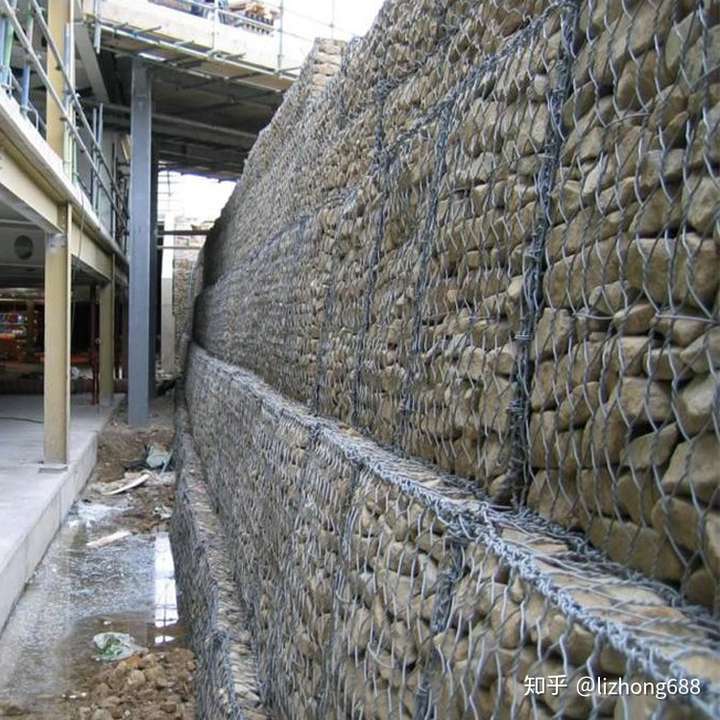Gabion cage is a wire mesh cage that is cut and folded from heavy hexagonal nets. It is generally a cage assembled by folding and assembling 4 heavy hexagonal nets. Two small pieces of hexagonal mesh with a separator mesh in the middle.
The cages of the gabion net can also be made into triangles and trapezoids. The dams stacked with such gabion net cages are inclined on a plane.
Gabion cages are often used as retaining walls in water conservancy projects. Gabion mesh retaining walls are retaining walls made of 0.5m-1.0m gabion cages. The gabion cage retaining wall is mainly used for steep hillsides, and its function is to control debris flow, prevent landslides, and protect the roadbed of roads and railways.
The reason why gabion cages are used is because of their unique ecological functions. A little bit of soil is sprinkled on the surface of the protective body, and greening can be carried out. Because there are gaps between the stones, the gaps accommodate the soil, which is conducive to the development of plant roots and creates a good ecological environment. Even if the soil is not sprinkled, over time, the gaps between the stones will silence the soil, which will grow some herbs and form a natural ecological environment. After the production of the gabion cage is completed, in order to save the volume, it can be bundled and compressed.

Specification
(1) Aperture: 60*80mm, 80*100mm, 80*120mm, 100*120mm, 120*150mm, 90*110mm
The length of the twisted part of the double wire shall not be less than 50mm. In order to ensure that the metal coating and PVC coating of the twisted part of the steel wire are not damaged.
(2) Wire diameter: gabion mesh is divided into three wire diameters – mesh wire, edge wire, tied wire
1. The range of mesh is 2mm-4mm
2. The edge wire is generally larger than the mesh wire, 0.5-1.0mm thicker than the mesh wire
3. The binding wire is generally smaller than the mesh wire, and the most common one is 2.2cm
(3) Steel wire tension: not less than 38kg/m2 380N/mm
(4) Surface treatment
1. Electro-galvanized. The amount of zinc is 10g/m2. Poor corrosion resistance
2. Hot dip galvanized. The amount of zinc can reach 300g/m2. Strong corrosion resistance
3. Galvan (zinc-aluminium alloy). This is divided into two materials, zinc-5% aluminium-mixed rare earth alloy steel wire, zinc-10% aluminium mixed rare earth alloy steel wire. Super anti-corrosion
4. PVC coated. The thickness of the plastic wrap is generally 1.0mm thick, for example, 2.7mm is 3.7mm after wrapping. Strong corrosion resistance
(5) Partition: add a partition per meter in the long direction of the gabion net
(6) Size: can be customized according to the standard
(7) The range of aperture and wire diameter compared
Gabion cage assembly standard requirements
1. Assembling the gabion cage
(1) The spacer net and the net body should intersect at a 90° angle, and are bound to form a rectangular cage group or cage.
(2) The binding wire must be a steel wire of the same material as the network cable.
(3) Each binding must be double-stranded and twisted tightly.
(4) The number of binding lanes at the junction of various mesh pieces that constitute a caged group or cage should meet the following requirements:
①The spacer net and the four corners of the net body are tied together;
②The junction of the spacer net and the net body is tied every 25cm;
③ The adjacent frame lines between the spacer net and the net body must be connected by combination lines. That is, the binding wire is used—the hole is wound—the ring is connected—the hole is wound around the hole twice in a helical perforation and twisted connection.

2. The connection and binding between the gabion cage groups should meet the following requirements:
(1) The upper and lower four corners of adjacent cage groups are tied together;
(2) The upper and lower frame lines or broken lines of adjacent cage groups must be tied at intervals of 25cm;
(3) The mesh joint surfaces of adjacent cage groups are bound at 2 places per square meter.
(4) The mesh in the exposed part should be set with a tie line after filling 1/3 of the height of the stone in each box, and it should be tightened and fixed inward in a figure-eight shape.
3. Construction of gabion cage cover
(1) The capping must be done on the basis of the top stone masonry.
(2) The adjacent nodes at each end must be fixed with cover clips before binding.
(3) The intersection line between the cover and the cage frame should be tied every 25cm.

